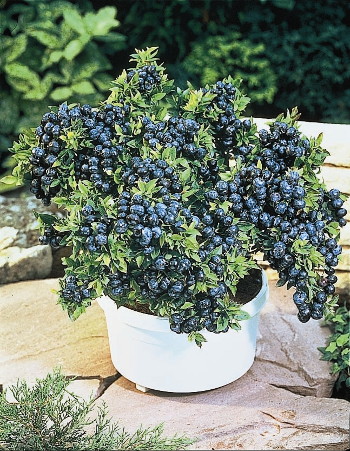Fruit to Grow in Pots: Best Varieties
 Blueberries, cherries, and other small fruit shrubs produce faster in big tubs and pots! Here are some varieties I recommend.
Blueberries, cherries, and other small fruit shrubs produce faster in big tubs and pots! Here are some varieties I recommend.First, I already have four fruit shrubs in the ground. About a third of the berries were eaten this year (mostly by me) in the garden while picking. Another third was used fresh for tarts and fruit salads. The remainder was frozen for later use. However, my frozen stash never lasts me through the winter. I’m running out of ground, so I’m going to containers.
Why pots? Fruits grown in containers are easier to protect from birds and other critters, more disease resistant and easy to harvest. Potted berries can be picked when ripe by placing their container on a bed sheet or tarp and shaking the pot.
There are so many fruit shrubs today that are perfect for pots, such as the Top Hat blueberry, which was bred by the University of Michigan for small spaces and containers. What could be simpler?

Top Hat is perfect on patios and decks, where it offers three-season interest. Gorgeous white bell flowers blanket plants in the spring, blue berries form during the summer and coppery fall foliage persists until the snow falls. Photo courtesty of Spring Hill Nursery.
Pink blueberries
In the last three years, I’ve received two pink blueberry varieties to test in my garden. One, Pink Lemonade has been in the ground for three summers and hasn’t bore fruit. A second shrub was planted in a large tub and flowered last spring! I expect to harvest my first pink blueberry this year. Because pink blueberries contain genetics from rabbit eye blueberries (a standard in the hot South), these pink berries can be planted in nearly every climate.The same breeder also sent Pink Champagne, another pink variety last June. It, too, is in a large container. All the potted plants have grown vigorously and are larger than the one in the ground! I’m excited about sampling these new berries that is full of antioxidants and supposed to be sweeter than blue blueberries.

Pink Lemonade blueberries are loaded with the same antioxidants and vitamins as their blue cousins. Photo courtesty of Garden Media Group.
Sweet cherries for a pot
Spring Hill Nursery gave me a Carmine Jewel seedling last March to try. It was in a 2-inch pot, and I immediately potted up to a 6-inch one and kept it indoors until nights were above 25F. Then, the shrub went into a large tub. The plant is almost 4-feet tall now and wintering in my unheated garage.
I’m sure these cherries won’t make it in the house, because I’ll eat them in the garden! Photo courtesty of Spring Hill Nursery.
Carmine Jewel is self-fruitful and can be picked before it’s fully ripe to use as one would a sour cherry, for pies, etc. It’s a cold-hardy sour cherry, but it has super-high sugar content when allowed to turn deep red and soften. You get two types of cherries in one shrub.
Do you grow berries? What do you think about potting fruit? Please share your comment below!https://www.almanac.com/blog/gardening-blog/potting-fruit-fast-harvests?trk_msg=O2LB3MQ7MHFKFB9KE5SQ2C942O&trk_contact=EEBLFVJ2I0VAQT9EM5JFVJAK9O&trk_sid=R5VNNU770J625V07N5HGNF7S48&utm_source=Listrak&utm_medium=Email&utm_term=Fruit+to+Grow+in+Pots%3a+Best+Varieties+(title)&utm_campaign=Companion+Daily







